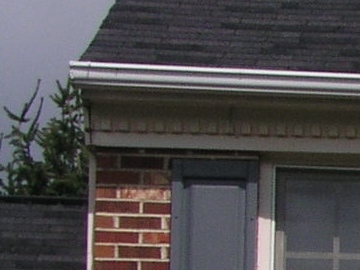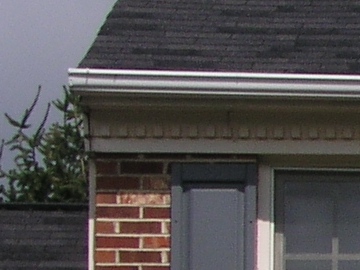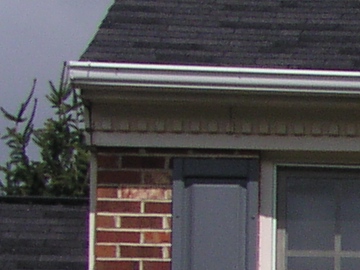
|
Image compression in the Olympus C-5050Z |

| My other pages related to the Olympus C-5050Z, C-5060WZ, and X-7070WZ |
|
The Olympus C-5050Z camera allows for saving images in a number of size, format, and compression settings. Of these, size variations are not of much interest, as they are not really worth bothering with: resizing can be done equally well (if not better) at the postprocessing stage. Besides, once you set a non-native image size, it is all too easy to forget to reset it back — one more thing to remember... On the other extreme, the ORF (Olympus Raw Format) stores the image straight as taken from the CCD: the readings taken at individual red, green, and blue photosites, without converting them to RGB pixels, and without any other in-camera processing (sharpening, color balance, contrast adjustment, etc.) More, each photosite signal is stored in the original 10-bit depth, (as opposed to eight bits per color in JPEG or TIFF). This allows for more flexibility in postprocessing (for example, better shadow and/or highlight detail), but only if done by a qualified user, who knows exactly how to do it. Storing the image in the ORF format and then automatically converting it to the 8-bit (per color) depth does not really offer much of an advantage over the same process done by the camera. This is why most of us really are facing the choice between three storage options:
(Obviously, the terms "high" and "super high" are relative and really mean nothing; this became usual in manufacturers' jargon. I'm still waiting for a company which would not offend our intelligence here.) One has to remember that the JPEG compression introduces some quality degradation (detail loss and compression artifacts); the higher the compression, the more quality loss may occur (this varies somewhat from image to image). Therefore, we are facing the choice between the smaller file size (more pictures on a card, shorter write times) offered by the HQ JPEG mode, and the higher image quality offered by the TIFF format, with the SHQ mode somewhere in-between. First, let us quickly compare the file sizes and write speeds of the three formats. |
Standard

|
HQ JPEG

|
SHQ JPEG

|
TIFF

|
|---|---|---|---|
| Compression (nominal) | 1:11 | 1:4 | None |
| File size | 1.2 MB | 3.6 MB | 14.7 MB |
| Images on a 256 MB card | 210 | 71 | 17 |
| Save time | 3 s | 4 s | 17 s |
|
The nominal compression ratios and image sizes are quoted after Olympus (in "decimal", not the "binary" megabytes usual in computer applications; sizes in the latter units will be by about 5% smaller). Based on my experience, the actual JPEG file sizes are, on average, somewhat smaller, and compression ratios — higher. Similarly, the number of images fitting on a 256 MB card is shown as indicated by the camera, close enough for any practical purposes. The numbers speak for themselves, so I will avoid any further comments. Now, let us visually compare the image quality provided by three formats. To do this, I shot the same subject at all three settings. The camera was handheld, which does not matter here, as the exposure was 1/800s at F/5.6. To get saturated colors and to preserve detail in the highlights, I have used an exposure compensation of -0.7 EV. The in-camera sharpness adjustment was at -2, contrast at -1, and color saturation at +2, which are my most often used settings. The first picture below shows the full frame of the scene, reduced in size and re-sharpened; the others are full-size fragments, re-saved at very low JPEG compression, but otherwise not manipulated in any way. | ||

|

| |
| The full frame, reduced in size and re-sharpened | HQ JPEG sample, 1:1 pixel size | |

|

| |
| SHQ JPEG sample, 1:1 pixel size | TIFF sample, 1:1 pixel size, converted to very low compression JPEG (a lossless TIFF sample can be found here) | |
|
Let me remind you, that each of the 1:1 samples shown here would be just 1 1/8 of an inch tall as a part of a full-frame, 8" tall print (8"x10 2/3"). (This is 28 mm in a 20-cm tall print, for my European readers.) This means that you see the images (and all their flaws) magnified. Surprise: it is really quite difficult to see quality differences between all three samples. If you download the images to your computer and view them double size, you may see some artifacts in the sky between tree branches at the left in the HQ sample, but that's about it. For example, I find the chtomatic aberration at the roof edge (as insignificant as it is) more objectionable. For my money, saving the pictures in the TIFF format is just not worth the extra size and time. From my own experience, the HQ format is enough for all practical purposes (by which I mean prints up to 9x12"), with the lower-compression SHQ sometimes useful for more critical work. This simply shows how ingenious the old, trusty JPEG compression scheme is. The new JPEG 2000 standard, slowly gaining recognition, is even better (i.e., providing less loss at the same compression ratio); I'm still waiting for the first camera manufacturer who will include it as an option. | ||

| My other pages related to the Olympus C-5050Z, C-5060WZ, and X-7070WZ |
|
Camedia® and Olympus® are registered trademarks of Olympus Corporation.
This page is not sponsored or endorsed by Olympus (or anyone else) and presents solely the views of the author. |
| Home: wrotniak.net | Search this site | Change font size |
| Posted 2003/09/24 | Copyright © 2003 by J. Andrzej Wrotniak |